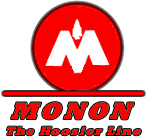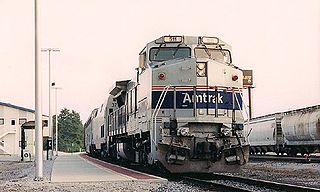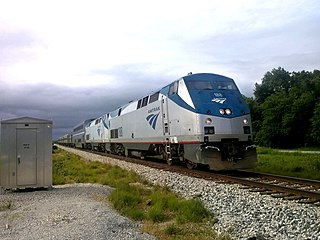
Tower City Center is a large mixed-use facility in Downtown Cleveland, Ohio, on its Public Square. The facility is composed of a number of interconnected office buildings, including Terminal Tower, the Skylight Park mixed-use shopping center, Jack Cleveland Casino, Renaissance Cleveland Hotel, Chase Financial Plaza, and Tower City station, the main hub of Cleveland's four RTA Rapid Transit lines.

Baltimore Penn Station, formally named Baltimore Pennsylvania Station in full, is the main inter-city passenger rail hub in Baltimore, Maryland. Designed by New York City architect Kenneth MacKenzie Murchison (1872–1938), it was constructed in 1911 in the Beaux-Arts style of architecture for the Pennsylvania Railroad. It is located at 1515 N. Charles Street, about a mile and a half north of downtown and the Inner Harbor, between the Mount Vernon neighborhood to the south, and Station North to the north. Originally called Union Station because it served the Pennsylvania Railroad and Western Maryland Railway, it was renamed to match other Pennsylvania Stations in 1928.

Dearborn Station was, beginning in the late 1800s, one of six intercity train stations serving downtown Chicago, Illinois. It remained in operation until May 1, 1971. Built in 1883, it is located at Dearborn and Polk Streets, adjacent to Printers Row. The station was owned by the Chicago & Western Indiana Railroad, which itself was owned by the companies operating over its line. The station is now a shopping mall housing office, retail, and entertainment spaces.

Chicago Union Station is an intercity and commuter rail terminal located in the West Loop neighborhood of the Near West Side of Chicago. The station is Amtrak's flagship station in the Midwest. While serving long-distance passenger trains, it is also the downtown terminus for six Metra commuter lines. Union Station is just west of the Chicago River between West Adams Street and West Jackson Boulevard, adjacent to the Chicago Loop. Including approach and storage tracks, it covers about nine and a half city blocks.

The Monon Railroad, also known as the Chicago, Indianapolis, and Louisville Railway from 1897 to 1971, was an American railroad that operated almost entirely within the state of Indiana. The Monon was merged into the Louisville and Nashville Railroad in 1971, and much of the former Monon right of way is owned today by CSX Transportation. In 1970, it operated 540 miles (870 km) of road on 792 miles (1,275 km) of track; that year it reported 1320 million ton-miles of revenue freight and zero passenger-miles.

Denver Union Station is the main railway station and central transportation hub in Denver, Colorado. It is located at 17th and Wynkoop Streets in the present-day LoDo district and includes the historic station house, a modern open-air train shed, a 22-gate underground bus station, and light rail station. A station was first opened on the site on June 1, 1881, but burned down in 1894. The current structure was erected in two stages, with an enlarged central portion completed in 1914.

The Cardinal is a long-distance passenger train operated by Amtrak between New York Penn Station and Chicago Union Station via Philadelphia, Washington, D.C., Charlottesville, Charleston, Huntington, Cincinnati, and Indianapolis. Along with the Capitol Limited and Lake Shore Limited, it is one of three trains linking the Northeast and Chicago. Its 1,146-mile (1,844 km) trip between New York and Chicago takes 281⁄4 hours.

The Kentucky Cardinal was a nightly 312-mile (502 km) passenger train operated by Amtrak from 1999 to 2003 between Chicago, Illinois, and Louisville, Kentucky, via Indianapolis, Indiana. On the three days that the Cardinal ran, the Kentucky Cardinal operated as a section, splitting at Indianapolis. On the other four days, it ran on its own to Chicago.

The Floridian was a train operated by Amtrak from 1971 to 1979 that ran from Chicago and Florida, with two branches south of Jacksonville terminating at Miami and St. Petersburg. For its Nashville to Montgomery segment, its route followed that of several former Louisville & Nashville Railroad (L&N) passenger trains, including the Pan-American and the Humming Bird. Originating in Chicago, the train served Lafayette and Bloomington, Indiana; Louisville and Bowling Green, Kentucky; Nashville, Tennessee; Decatur, Birmingham, Montgomery and Dothan, Alabama; and Thomasville, Valdosta and Waycross, Georgia.

The Union Station of Louisville, Kentucky is a historic railroad station that serves as offices for the Transit Authority of River City (TARC), as it has since mid-April 1980 after receiving a year-long restoration costing approximately $2 million. It was one of at least five union stations in Kentucky, amongst others located in Lexington, Covington, Paducah and Owensboro. It was one of three stations serving Louisville, the others being Central Station and Southern Railway Station. It superseded previous, smaller, railroad depots located in Louisville, most notably one located at Tenth and Maple in 1868–1869, and another L&N station built in 1858. The station was formally opened on September 7, 1891, by the Louisville and Nashville Railroad. There was a claim made at the time that it was the largest railroad station in the Southern United States, covering forty acres. The other major station in Louisville was Central Station, serving the Baltimore and Ohio, the Illinois Central and other railroads.

St. Louis Union Station is a National Historic Landmark and former train station in St. Louis, Missouri. At its 1894 opening, the station was the largest in the world that had tracks and passenger service areas all on one level. Traffic peaked at 100,000 people a day in the 1940s. The last Amtrak passenger train left the station in 1978.

Columbus Union Station was an intercity train station in Downtown Columbus, Ohio, near The Short North neighborhood. The station and its predecessors served railroad passengers in Columbus from 1851 until April 28, 1977.

Staunton station is an Amtrak train station in Staunton, Virginia, located in the downtown Wharf Area Historic District of the city. It is served by Amtrak's Cardinal, which runs between New York and Chicago.

Lafayette station is an Amtrak station in Lafayette, Indiana, served by the Cardinal. The current station facility was established in 1994. The Amtrak train previously stopped in the middle of the city's 5th Street, near the former Monon Railroad depot. The station building was moved to its current location from the southeast corner of 2nd and South streets in September 1994. It is a Romanesque Revival style depot built in 1902 by the Lake Erie and Western Railroad and Cleveland, Cincinnati, Chicago and St. Louis Railway, as the Big Four Depot. The station was listed on the National Register of Historic Places in 2003.

Quaker Square was a shopping and dining complex located in downtown Akron, Ohio which is now used by the University of Akron. Quaker Square was the original Quaker Oats factory; the complex consists of the former mill, factory, and silos. The buildings were bought in the early 1970s by developers who sought to create a unique, useful home for shops and restaurants. The buildings were bought by the University of Akron in 2007. The hotel has been converted to a residence hall. The retail space consisted of dozens of small shops and restaurants, and there were large areas of historic exhibits on such areas as the local Quaker industry and history of radio in Akron, while offices were on the floors above. Quaker Square was open to the general public until September 18, 2015. The hotel no longer accepts reservations as the former hotel rooms and the entire complex is operated exclusively for student and university use. However, ballrooms are still available for catered events and conferences.

The Hoosier State was a 196-mile (315 km) passenger train service operated by Amtrak between Chicago and Indianapolis. It ran on the four days each week that the Cardinal did not run, giving daily rail service to the Chicago–Indianapolis corridor.

The James Whitcomb Riley was a passenger train that operated between Chicago, Illinois, and Cincinnati, Ohio, via Indianapolis, Indiana. Originally operated by the New York Central Railroad, it was taken over by Amtrak in 1971. Under Amtrak, it merged with the Chesapeake & Ohio Railway's George Washington to become a Chicago-Washington/Newport News train. In 1977, it was renamed the Cardinal, which remains in operation.

The National Limited was a passenger train that ran between Kansas City, Missouri, and both New York City and Washington, D.C., splitting in Pennsylvania. Amtrak operated the train from 1971 to 1979.

Iowa Pacific Holdings was a holding company that owned railroad properties across North America and the United Kingdom, as well as providing services such as railcar repairs, leasing, management and consulting services to other operators. The company was founded in 2001 with headquarters in Chicago, Illinois.
Marion station was a train station in Marion, Indiana.

































